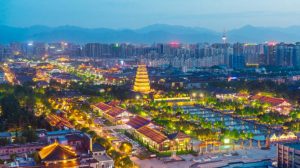Top 10 Must-Visit Attractions in Xi’an, China
In a Lifetime, One Must Visit Xi’an: 10 Must-See Attractions
Xi’an is one of China’s most historically significant capitals, boasting a rich cultural heritage and a deep-rooted history. According to the “Records of the Grand Historian,” Xi’an was known as the “Golden City of a Thousand Miles” and served as a central hub for politics, culture, and economics in ancient China. Today, Xi’an’s wealth of historical landmarks and unique geographic location attracts countless visitors. Below, we present 10 essential attractions to explore, lovingly handpicked for your enjoyment.
Attraction 1: Qin Shi Huang’s Mausoleum and the Terracotta Warriors(秦始皇帝陵博物院-兵马俑)
Within the Qin Shi Huang Mausoleum lies a vast burial pit renowned for its Terracotta Warriors. This museum is China’s largest ancient museum, built on the original site. The museum features three pits of Terracotta Warriors. Pit 1 contains the main force with alternating chariots and infantry, approximately 6,000 life-sized clay warriors. Pit 2 features a mix of chariots, cavalry, and archers, while Pit 3 serves as the command center for the army. The excavated Terracotta Warriors include generals, infantrymen, and charioteers, each displaying unique facial expressions. Though originally painted, most have lost their color due to exposure to fire and moisture. The museum also houses the Bronze Chariots and Horses Exhibition Hall, featuring intricately crafted bronze chariots and horses adorned with gold and silver, often referred to as the “Crown of Bronze,” of significant value in the study of the Qin Dynasty.
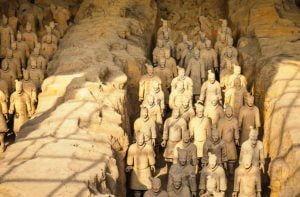
Attraction 2: Xi’an City Wall(西安城墙)
Take a leisurely bike ride along the 600-year-old ancient city wall, overlooking the historical capital of thirteen dynasties. The Xi’an Ming Dynasty City Wall is China’s most well-preserved ancient city wall and ranks second in length nationwide. It is encircled by a moat, and the famous Xi’an Bell Tower is located at its center. Visitors can choose to stroll at their own pace or cycle around the wall, though it’s essential to be cautious, as the road on the wall is not entirely smooth.
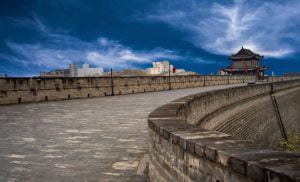
Attraction 3: Huaqing Palace(华清宫)
Huaqing Palace, one of China’s oldest imperial gardens, is said to be the bathing place of the legendary Yang Guifei. This site has been a royal retreat for centuries, with a history dating back to the Western Zhou dynasty. It holds well-preserved cultural relics, classical gardens, ancient architecture, and ancient trees from various dynasties, including the Zhou, Qin, Han, Tang, Ming, and Qing periods. The palace is famous for the passionate love story of Emperor Xuanzong and Yang Guifei and the “Xi’an Incident” that shocked the nation. Throughout history, it has seen renovations during the Qin, Han, and Sui dynasties, with significant expansion during the Tang Dynasty.
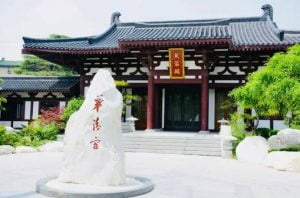
Attraction 4: The Great Tang All Day Mall(大唐芙蓉园)
The Great Tang All Day Mall is the largest cultural-themed park in the northwest region, featuring the world’s largest water-screen movie performance and China’s largest group of Tang-style buildings. The park dazzles at night, with the brilliant lights of the Tang Culture Corridor, Fanglin Garden, and Zi Yun Tower. Visitors can enjoy activities such as sky drumming, “Tang Dynasty Musical,” palace performances, and a costume show. Additionally, the large-scale dance drama “Dream Back to the Great Tang” performed at the Phoenix Nine Skies Theater is a comprehensive dance performance embodying the essence of the Tang Dynasty.
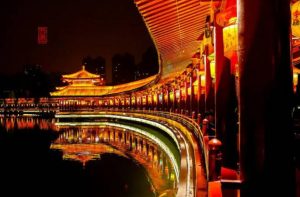
Attraction 5: The Big Wild Goose Pagoda(大雁塔)
The Big Wild Goose Pagoda, personally supervised by Xuanzang, remains intact after a thousand years. It is one of China’s famous Buddhist pagodas and a unique symbol of ancient Xi’an. The pagoda has an elegant tower structure, built of bricks in the shape of a square cone, with a spiral staircase inside. Each level has a vaulted doorway on all four sides, offering stunning panoramic views of Chang’an from the railing. At the pagoda’s base, you can find the stone steles “Preface to the Great Tang Tripiṭaka” and “Record of the Sacred Teachings of the Great Tang.”
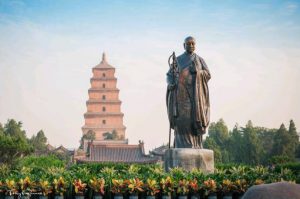
Attraction 6: Shaanxi History Museum(陕西历史博物馆)
Hailed as the “Treasure House of Chinese Culture” and the “Magnificent Hall of Chinese Civilization,” the Shaanxi History Museum is located northwest of the Big Wild Goose Pagoda in Xi’an. It’s China’s first large modern national museum. The museum’s collection includes over 370,000 cultural relics spanning over a million years, from primitive stone tools of ancient humans to various artifacts used in social life before 1840. The museum features exquisite Shang-Zhou bronze ware, diverse figurines from different periods, and unrivaled Tang Dynasty mural paintings. This museum is a masterpiece that encapsulates the essence of Chinese history, showcasing Shaanxi’s historical and cultural significance.
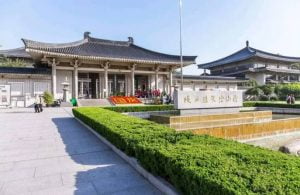
Attraction 7: The Big Tang All Day Mall(大唐不夜城)
The Big Tang All Day Mall is a comprehensive cultural-themed attraction combining shopping, dining, entertainment, leisure, tourism, and business. Based around the Big Wild Goose Pagoda, it stretches from Xuanzang Square in the north to the Tang Dynasty Wall Site Park in the south, from Cien East Road in the east to Cien West Road in the west, encompassing three main plazas and six Tang-style blocks. The Cien Cultural Square comprises four cultural and artistic buildings: Xi’an Grand Theatre, Xi’an Concert Hall, Qujiang Art Museum, and Qujiang Pacific Cinema. The central sculpture promenade is a 1,500-meter-long central sculpture and landscape pedestrian street with nine themed group sculptures, including prosperous emperors, historical figures, hero stories, and classic artworks.
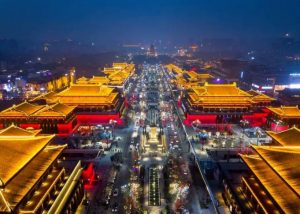
Attraction 8: Xi’an Bell Tower(西安钟楼)
The Xi’an Bell Tower is one of the largest and best-preserved ancient buildings in China. It hosts six bell chime performances daily. The roof is covered with dark green glazed tiles, and the interior is decorated with gold and colorful paintings, with intricate carvings and exquisite structures. From the Bell Tower, you can see four streets extending in the east, south, west, and north directions, as well as the bustling commercial district surrounding the Bell Tower. While visiting the Bell Tower, you can also enjoy fascinating historical reenactments. Between the Bell Tower and the Drum Tower, there’s the Bell and Drum Tower Square with a music fountain.
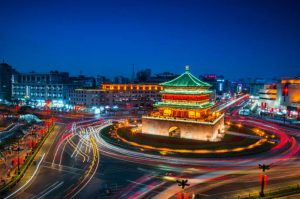
Attraction 9: Xi’an Drum Tower(西安鼓楼)
The Drum Tower, located 200 meters from the Bell Tower, is another one of the largest and best-preserved ancient buildings in China, similar in structure and historical significance to the Bell Tower. The entire structure is held together without the use of a single nail. Built on the foundations of the Tang Dynasty architectural style and incorporating innovations from the Song Dynasty, the Drum Tower has a magnificent and grand appearance. It originally housed a giant drum, which was beaten to mark the hours. Thus, it was named the “Drum Tower.” Over the centuries, the enormous drum has been lost, but the tower itself still stands tall. The roof is covered with dark green glazed tiles, and the interior is decorated with gold and colorful paintings. The roof is crowned with a golden roof that shines brilliantly. The building exudes an ancient and robust charm with rich national characteristics.
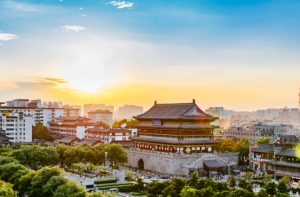
Attraction 10: Daci’en Temple(大慈恩寺)
Daci’en Temple is the most famous and magnificent Buddhist temple within the ancient Changan city of the Tang Dynasty, built under imperial orders of the Li Tang royal family. The temple was established in memory of Empress Zhangsun, the mother of Emperor Taizong. In the 22nd year of Emperor Taizong’s Zhenguan era (648 AD), Crown Prince Li Zhi, who later became Emperor Gaozong, built the temple to commemorate his mother, the Empress Zhangsun. The temple was entrusted to Xuanzang, who served as the abbot and oversaw the translation of Buddhist texts. During his time here, Xuanzang founded the Yogacara school of Buddhism, one of the eight great schools of Chinese Buddhism. The Daci’en Temple’s Big Wild Goose Pagoda, originally called the Floating Pagoda of the West Courtyard of the Daci’en Temple, was personally constructed under Xuanzang’s supervision. As such, the Daci’en Temple holds a prominent position in the history of Chinese Buddhism, receiving consistent attention from the domestic and international Buddhist communities.
